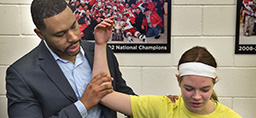
The risks are real for youth sports and heightened awareness is making it easier for parents, coaches and school officials to keep kids safe.
“We’re seeing lots of controversies, and in many places, a decline in the number of kids participating in football,” said Matthew Axtman, DO, a specialist in non-surgical orthopedics and sports medicine at Spectrum Health Medical Group Orthopedics and Sports Medicine.
And there’s growing concern about other contact sports, as well.
“Parents are weighing the risk of sports injuries against the risks that come from inactivity, including obesity,” Dr. Axtman said.
But amid growing fears about the long-term effects of traumatic brain injury, it’s easy to lose perspective. A new study finds that parents perceive the risk of concussion as greater than it really is.
Conversely, Dr. Axtman said, they may underestimate other problems, such as overtraining. “All sports, including soccer, hockey, lacrosse and cheerleading, have some risks.”
Besides proper training, conditioning and coaching, he and James Lebolt, DO, who specializes in surgical orthopedic sports medicine, said it’s essential for parents to be alert to potential problems.
Concussion
In tracking kids playing football between the ages of 5 and 14, recent research reveals that 5% suffer a concussion each season. The odds intensify in high school when two out of 10 athletes who play contact sports—including soccer and lacrosse—are likely to suffer a concussion a year.
“I’m very concerned about it,” Dr. Lebolt said, “including the number of concussions and the way we treat them. And I’m concerned not just as a physician, but as a parent of young children.”
What to do? Know the signs and symptoms, such as appearing dazed or unable to recall what happened before or after a hit. The U.S. Centers for Disease Control and Prevention’s Heads Up to School Sports is a great resource. The National Youth Sports Health and Safety Institute is another.
Make sure a health care provider evaluates your child if you suspect a concussion, and don’t let him or her return to school, practice or play until medically cleared. Pay attention to the condition of helmets and protective padding, and make sure they are worn in practices.
Be alert to a coach’s credentials, and ask if they’ve received recent training and certifications, such as Heads Up Football, backed by the NFL.
“Kids need to be taught and trained about how to take a hit,” Dr. Axtman said.
And while delaying contact until a certain age reduces injuries, it paradoxically puts kids at increased risk later by introducing them to tackling when they are bigger, stronger and faster. Ask about additional personnel, too: The use of athletic trainers on the sidelines has been shown to reduce injuries.
Overuse injuries
The response? Plenty of cross-training, and six to eight weeks off a year.
Instead of constant sports-specific workouts, “we’re working hard to encourage parents and kids to do more generalized strength training,” Dr. Lebolt said. “We want them to build up their core, legs, even neck musculature to buffer against things like concussions, neck injuries and ACL injuries. The right type of conditioning is protective.”
And Dr. Axtman said it’s important for kids to get up to six to eight weeks off each year.
“Parents often don’t want to hear that and will brag about how their child is a two- or three-sport athlete,” he said. “And so many kids go from school to club to rec to travel teams. They’re doing that sport all year long and not allowing their body to recover and recuperate.”
Without a break, they’re vulnerable to problems in joints, muscles and tendons.
Dr. Axtman said he’s alarmed by how often young athletes and their parents ask if it’s OK to play with an injury. “Saying `No’ is important. It’s not the end of the world to miss a few games. This isn’t the pros—these are kids.”
Burnout
Suggestion? Dial down the pressure and intensity.
Recent research from the Aspen Institute’s Project Play revealed that while nine out of 10 kids cite fun as the main reason they play a sport, coaches and parents can sometimes suck all the fun out of the game.
In the last decade, the number of kids between 6 and 12 who participated in organized sports has fallen from 45% to 38%.
“Sometimes, kids will even say, `I just don’t want to do this anymore,’” Dr. Axtman said. Parents can help by encouraging free play and sport sampling.
But both doctors agree that if your child wants to suit up for football or any other contact sport, and you’re comfortable with the caliber of the program, the rewards may be worth the risk.
“I would encourage them to play, especially with the evolution in concussion treatment,” Dr. Lebolt said. “Team sports are character-building. They’re good for strength and endurance. And they’re fun.”
 /a>
/a>
 /a>
/a>
 /a>
/a>